Knowledge Management and Experience Transfer in Major Maintenance Activities: A Practitioner’s Perspective
Abstract
:1. Introduction
1.1. Overview of Knowledge Management (KM) Challenges in MoOSTs
1.2. The Importance of Knowledge Management (KM) in MoOSTs
1.3. Knowledge Management Process (KMP) in MoOSTs
1.4. Experience Transfer in MoOSTs
1.5. Knowledge Management (KM) in Industry 4.0 and Its Relationship to Employees Competencies in MoOSTs
- (1)
- What knowledge management challenges, are identified in real-world practices, during MoOSTs?
- (2)
- To what extent does the knowledge management challenge in the literature identified during MoOSTs align with real-word practice?
- (3)
- Can examination of underlying cause of the knowledge management challenges identified during MoOSTs, foster the development of a proposal for a formalised platform for capture and transfer of tacit knowledge across MoOSTs organisations?
2. Research Design
2.1. Pilot Investigation
2.2. Ethics Approval
2.3. Sampling Technique
2.4. Sample Size
3. Data Analysis
3.1. Data Analysis of Survey Response (Frequency Analysis)—Participant Demographics and MoOSTs Characteristics
3.2. Data Analysis of Semi-Structured Interview-Thematic Analysis
“…in the utility industry (e.g., water distribution/sewer collection and treatment) we conduct maintenance and overhaul on large pumps, motors bar screens, large exhaust fans, tanks, dams, compressors, transmission/distribution pipes and reservoirs”.Maintenance planner, utility plant, US
“…in cement manufacturing, we have major maintenance for Kiln shutdown KSD, some call it major overhauls”.Reliability engineer, manufacturing plant, Nigeria
“…shutdowns of the bulk work.”Shutdown manager, manufacturing plant, UK
“Since COVID its move things forward and move them on dramatically and it’s a massive improvement, where we will have a small number of people in a room and then everybody else joining via teams so we can have can have large numbers of people at the meeting and only a small number in a meeting room. We’ve got better control over our meeting”.Maintenance manager, manufacturing plant in UK
“It used to be paper based probably, but now we’re pretty much fully electronic”.Document controller, transport and logistics plant, UK
“Since obviously COVID-19 happened and we couldn’t have lots of people in one room while we used to do this before, now the online shutdown meeting I mean, so now the contractors, usually the supervisor were issued with like an iPad or similar”.Knowledge expert, manufacturing plant, UK
“So a lot of it’s now electronic…there’s very, very little paper because it’s not a live document once you print something off, you know there’s any changes to it and it can be tracked”.Overhauls planner, utilities plant, US
“You know, we might go through a period of three or four years of using someone then we’ve done a lot of that work, and then we’ve gained this skills ourselves to be able to then supervise it ourselves. Alternatively, we get a different expert in to then help us with the next part, once we gain the skills we can then do the work going forward and it’s sort of picks up like that”.Maintenance supervisor, manufacturing Plant, UK
“We don’t have specific people that do shutdown, we normally categorize the task based on what we can do in house and what we sub contract…”Contracts manager, Aerospace, UK
“The maintenance crew hardly changes. We do have our own internal mechanical, electrical, PDM and instrumentation maintenance crew that conduct maintenance on the assets/equipment”.Maintenance manager, utilities plant, US
“…that would be on production called (CPD), cost per day, if we overshoot, just the circumstantial losses for the plant could be in the range of say £100,000”.Maintenance manager, utilities plant, UK
“…the Kiln is rated at 5000 tons per day. Average clinker per day costs N14,000 per ton that is about N77 million per day and we usually overshoot by 3 days which brings the cost of delay to about N231m. If we use current exchange rate of £1—N620 it is about £372, 580…”Maintenance planner, manufacturing plant, Nigeria
“Each day lost can cost up to €30,000”Maintenance manager, utilities plant, UK
“In fact under-estimated brick work on the refractories are the two main drivers for overshooting budget and they make up over 50% of the overall shutdown costs”.Maintenance supervisor, manufacturing plant in Nigeria
“Bit of guesswork until we can get in and have a look at the real work to do yeah, yeah, exactly…”Reliability engineer, manufacturing plant in UK
“If it’s not supervised correctly and things like quality of work can be affected, it can extend the shutdown if you don’t keep on top of that”.Maintenance planner, water utility plant in the US
“The main delays can be where we have got too many people working in one area, and obviously this COVID-19 time, it was even more challenging to ensure we can maintain a safe work area. For instance, you could have mechanical team and then the scaffold team and it could be difficult to fit everyone”.Shutdown inspector, oil and gas, Nigeria
“Someone will be giving ownership of certain different parts. The person that’s either has a vested interest in it or is most suited”.Reliability engineer, aerospace and defence, UK
“We do not write reports, however before the project commence, the maintenance planner must create a job plan for the job”.Method and specific inspection, transport and logistics, UK
“The true purpose of the debrief exercise is to make sure that when we start the preparation and planning for the next major repair that we can put actions and recommendations in where we can improve and the report will be stored in our local network”.Maintenance manager, manufacturing plant, Nigeria
“…The plan is constantly fluid and live. I update the plan two or three times a day and then feedback that information. This could hamper the reuse of previous reports cause things are constantly changing”.Shutdown planner, manufacturing plant, UK
“Yeah, so just from having knowledge of this plant and knowing the whole operation. So it boils down to the fact that you like understand the operations of the plants and you’re familiar with the assets and things like that. So it’s not just textbook knowledge”.Inspector, utilities plant, US
“I learnt from repetitive tasks, from personalized training and the company policy of shuffling me to different projects from my early career”.Maintenance planner, manufacturing plant, Nigeria
“I would say it is just from lots of experience and debriefs, as well as understanding the plant and the contractors. Then I would say continuous reflections plays a big part in how successful major repairs are. Team work and collaboration is vital”.Maintenance manager, manufacturing plant, UK
“There is a lack of formalized training, so for example on the production team, if you start as a new member, the production team just the whole system where you go and do so many months in one area. …So you’re rotated round until you’ve witnessed all those bits. There doesn’t seem to be that in the maintenance out as much”.Maintenance manager, manufacturing plant, UK
“…to answer, I think it’ll just be you shadow someone that’s done it before you learn from their experiences and things like that, you know you sort of have to catch up quickly”.Reliability engineer, manufacturing, UK
“…there’s never been any formalized training on it”.Inspector, manufacturing plant, Nigeria
“There’s not a formalized training, probably just time and experience, but also spending time with other people”.Document controller, utilities plant, US
“I would say we have means people can learn from the team but it is not formalized, so it would be much more done through shadowing, mentoring and your peers assisting you”Maintenance manager, utilities plant, US
“I would say Time!! It takes time to reflect and look at what you are doing and some people have that ability while others don’t also quite often people get caught in the moment and just become like a conveyor belt in the work without giving much thoughts to what they are doing. Cause you never stop, you finish one shut down and go back to start another one. It is almost like a roller coaster of never catching a break”.Reliability engineer, manufacturing plant, UK
“Not documenting and sharing the lessons learned is a major problem because there is no time. When a maintenance team moves on, the lessons learned are not transferred to the next generation. In my opinion, a barrier to learning from experience results from maintenance teams with too few members not having the time to document the lessons learned. Organizations need to understand the value of documentation practices and resource them appropriately”.Document controller, manufacturing plant, UK
“There is the gap from the individual aspect and organization, if the system is there to encourage but the individual impacts on the overall efficiency and the duration of learning, and it is the major obstacle for passing down key skills learned from major overhauls”.Maintenance shutdown manager, manufacturing plant, Nigeria
“It’s a tough one, isn’t it? I think previously, maybe just before my time or just as after I started do it, almost a hesitancy for people to share knowledge”.Inspector, utilities plant, UK
4. Discussion of Findings
5. Concluding Remarks and Proposal for a MoOSTs Knowledge Platform (KP)
Limitations
Author Contributions
Funding
Institutional Review Board Statement
Informed Consent Statement
Data Availability Statement
Acknowledgments
Conflicts of Interest
Appendix A
- What are the major maintenance activities performed during MoOSTs?
- How is the team formed, is it always the same core team or is it formed for every new MoOSTs project?
- What are the main reasons for delays during MoOSTs?
- What is the normal duration for MoOSTs Planning?
- How long does the MoOSTs execution normally last?
- What is the impact of delays on production costs? (Please asides from a summary, provide monetary figures).
- What is the ICT utilized for planning, capturing knowledge during MoOSTs?
- Is the communication process during MoOSTs paper based, electronic or a mix of both?
- Do you organize meetings during MoOSTs to discuss ongoing projects? If yes, who participates at these meetings, how long do they last, where are they organized?
- Do you review MoOSTs project? If yes before or after?
- Do you write reports? If yes, who writes the report, and how is it stored?
- Could you give me any example of the issues that are treated in the reports or reviews?
- What happens to the information that are generated from review meetings during MoOSTs?
- Do you reference these reports in subsequent MoOSTs projects?
- How are contractors briefed during MoOSTs, is there a representative?
- How do you prioritize the knowledge you capture?
- What happens to the information that are generated, are they saved? If yes, how are they saved and shared (paper based, online repository or real time, intranet, web based that is continually updated and made available immediately)?
- What is the process for debriefing contractors?
- Do you have any formalized approaches of learning from experience? I.e., is there a way experts are able to transfer their expertise across projects?
- Can you give examples from your personal experience on how you learned new lessons?
- In your opinion, what are the major barriers to knowledge management and learning from experience?
- How do you think the barriers you have identified can be overcome, what measures do you envisage?
References
- Lewandowski, M. Designing the business models for circular economy—Towards the conceptual framework. Sustainability 2016, 8, 43. [Google Scholar] [CrossRef] [Green Version]
- Rizos, V.; Behrens, A.; Van Der Gaast, W.; Hofman, E.; Ioannou, A.; Kafyeke, T.; Flamos, A.; Rinaldi, R.; Papadelis, S.; Hirschnitz-Garbers, M.; et al. Implementation of Circular Economy Business Models by Small and Medium-Sized Enterprises (SMEs): Barriers and Enablers. Sustainability 2016, 8, 1212. [Google Scholar] [CrossRef] [Green Version]
- Khasreen, M.M.; Banfill, P.F.G.; Menzies, G.F. Life-Cycle Assessment and the Environmental Impact of Buildings: A Review. Sustainability 2009, 1, 674–701. [Google Scholar] [CrossRef]
- Kordab, M.; Raudeliūnienė, J.; Meidutė-Kavaliauskienė, I. Mediating Role of Knowledge Management in the Relationship between Organizational Learning and Sustainable Organizational Performance. Sustainability 2020, 12, 10061. [Google Scholar] [CrossRef]
- Iheukwumere-Esotu, L.; Yunusa-Kaltungo, A. A Systematic Analysis of Research Based Evidences of Major Overhauls, Outages, Shutdowns, Turnarounds (MoOSTs) Management. In Mechanisms and Machine Science; Springer: Berlin/Heidelberg, Germany, 2021; Volume 105. [Google Scholar] [CrossRef]
- Ambani, S.; Li, L.; Ni, J. Condition-Based Maintenance Decision-Making for Multiple Machine Systems. J. Manuf. Sci. Eng. 2009, 131, 031009. [Google Scholar] [CrossRef]
- Zhang, Z.; Liu, G.; Jiang, Z.; Chen, Y. A Cloud-Based Framework for Lean Maintenance, Repair, and Overhaul of Complex Equipment. J. Manuf. Sci. Eng. 2015, 137, 040908. [Google Scholar] [CrossRef]
- Shou, W.; Wang, J.; Wu, P.; Wang, X. Lean management framework for improving maintenance operation: Development and application in the oil and gas industry. Prod. Plan. Control 2021, 32, 585–602. [Google Scholar] [CrossRef]
- Al-Turki, U.; Duffuaa, S.; Bendaya, M. Trends in turnaround maintenance planning: Literature review. J. Qual. Maint. Eng. 2019, 25, 253–271. [Google Scholar] [CrossRef]
- Elwerfalli, A.; Khan, M.K.; Munive-Hernandez, J.E. Developing Turnaround Maintenance (TAM) Model to Optimise TAM Performance Based on the Critical Static Equipment (CSE) Of GAS Plants. Int. J. Ind. Eng. Oper. Manag. 2018, 1, 12–31. [Google Scholar]
- Shou, W.; Wang, J.; Wu, P.; Wang, X. Value adding and non-value adding activities in turnaround maintenance process: Classification, validation, and benefits. Prod. Plan. Control 2019, 31, 60–77. [Google Scholar] [CrossRef]
- Levitt, J. Managing Maintenance Shutdowns and Outages; [S.l.]. Industrial Pr Inc.: New York, NY, USA, 2004; 244p. [Google Scholar]
- Duffuaa, S.O.; Hadidi, L.A. Using QFD to conduct performance assessment for turnaround maintenance in petrochemical infrastructure. J. Infrastruct. Syst. 2017, 23. [Google Scholar] [CrossRef]
- Ashok, M.; Biswajit, S.; Jibitesh, M. Activity Crashing in Shutdown Maintenance Through Qualitative Assessment: A Case Study. Adv. Prod. Eng. Manag. 2011, 6, 239–248. [Google Scholar]
- Utne, I.; Thuestad, L.; Finbak, K.; Thorstensen, T.A. Shutdown preparedness in oil and gas production. J. Qual. Maint. Eng. 2012, 18, 154–170. [Google Scholar] [CrossRef]
- Egbunike, O.; Purvis, L.; Naim, M.M. A systematic review of research into the management of manufacturing capabilities. Prod. Plan. Control 2018, 29, 1349–1366. [Google Scholar] [CrossRef]
- Raoufi, M.; Fayek, A.R. Process Improvement for Power Plant Turnaround Planning and Management. Int. J. Archit. Eng. Constr. 2014, 3, 168–181. [Google Scholar] [CrossRef] [Green Version]
- Ruiz, P.P.; Foguem, B.K.; Grabot, B. Generating knowledge in maintenance from Experience Feedback. Knowl.-Based Syst. 2014, 68, 4–20. [Google Scholar] [CrossRef] [Green Version]
- Kannan, K.; Arunachalam, N. A Digital Twin for Grinding Wheel: An Information Sharing Platform for Sustainable Grinding Process. J. Manuf. Sci. Eng. Trans. ASME 2019, 141. [Google Scholar] [CrossRef]
- Hadidi, L.A.; Khater, M.A. Loss prevention in turnaround maintenance projects by selecting contractors based on safety criteria using the analytic hierarchy process (AHP). J. Loss Prev. Process Ind. 2015, 34, 115–126. [Google Scholar] [CrossRef]
- Mhlanga, M.Z.; Munapo, E.; Mavetera, N. Investigating causes of delays and cost escalation in project execution during turnarounds. Invest. Manag. Financ. Innov. 2016, 13, 334–348. [Google Scholar] [CrossRef] [Green Version]
- Refaiy, M.; Labib, A. The effect of applying tacit knowledge on maintenance performance: An empirical study of the energy sector in the UK and Arab countries. Knowl. Manag. Res. Pract. 2009, 7, 277–288. [Google Scholar] [CrossRef]
- Elwerfalli, A.; Khan, M.K.; Munive, J.E. A new methodology for improving TAM scheduling of oil and gas plants. Lect. Notes Eng. Comput. Sci. 2016, 2224, 807–812. [Google Scholar]
- Bell, N. Mitigating the Loss of Critical Knowledge. Saf. Reliab. 2014, 34, 61–78. [Google Scholar] [CrossRef] [Green Version]
- Costa, E.; Soares, A.L.; de Sousa, J.P. Information, knowledge and collaboration management in the internationalisation of SMEs: A systematic literature review. Int. J. Inf. Manag. 2016, 36, 557–569. [Google Scholar] [CrossRef] [Green Version]
- Martínez, L.B.; Márquez, A.C.; Gunckel, P.V.; Andreani, A.A. The graphical analysis for maintenance management method: A quantitative graphical analysis to support maintenance management decision making. Qual. Reliab. Eng. Int. 2013, 29, 77–87. [Google Scholar] [CrossRef]
- Eken, G.; Bilgin, G.; Dikmen, I.; Birgonul, M.T. A Lessons Learned Database Structure for Construction Companies. Procedia Eng. 2015, 123, 135–144. [Google Scholar] [CrossRef] [Green Version]
- Suryani, R.; Munadi, K.; Idroes, R.; Sofyan, H. International Journal of Disaster Risk Reduction Knowledge management practices in disaster management: Systematic review. Int. J. Disaster Risk Reduct. 2020, 51, 101881. [Google Scholar] [CrossRef]
- Almeida, F.; Miranda, E.; Falcão, J. Challenges and facilitators practices for knowledge management in large-scale scrum teams. J. Inf. Technol. Case Appl. Res. 2019, 21, 90–102. [Google Scholar] [CrossRef]
- Asrar-ul-Haq, M.; Anwar, S. A systematic review of knowledge management and knowledge sharing: Trends, issues, and challenges. Cogent Bus. Manag. 2016, 3, 1127744. [Google Scholar] [CrossRef]
- Ertl, B. Applying PMBOK to Shutdowns, Turnarounds and Outages; Republished with Permission (Plant Maintenance Resource Centre); Inter Plan System Inc.: Friendswood, TX, USA, 2005; Volume 20, p. 8. [Google Scholar]
- Gururajan, V.; Fink, D. Attitudes towards knowledge transfer in an environment to perform. J. Knowl. Manag. 2010, 14, 828–840. [Google Scholar] [CrossRef]
- Fang, S.C.; Yang, C.W.; Hsu, W.Y. Inter-organizational knowledge transfer: The perspective of knowledge governance. J. Knowl. Manag. 2013, 17, 943–957. [Google Scholar] [CrossRef]
- Peng, H. Why and when do people hide knowledge? J. Knowl. Manag. 2013, 17, 398–415. [Google Scholar] [CrossRef] [Green Version]
- Martelo-Landroguez, S.; Cepeda-Carrión, G. How knowledge management processes can create and capture value for firms? Knowl. Manag. Res. Pract. 2016, 14, 423–433. [Google Scholar] [CrossRef] [Green Version]
- Zaim, H.; Muhammed, S.; Tarim, M. Relationship between knowledge management processes and performance: Critical role of knowledge utilization in organizations. Knowl. Manag. Res. Pract. 2019, 17, 24–38. [Google Scholar] [CrossRef]
- Motamedi, A.; Hammad, A.; Asen, Y. Knowledge-assisted BIM-based visual analytics for failure root cause detection in facilities management. Autom. Constr. 2014, 43, 73–83. [Google Scholar] [CrossRef]
- Schiuma, G.; Carlucci, D.; Lerro, A. Managing knowledge processes for value creation. VINE 2012, 42, 4–14. [Google Scholar] [CrossRef]
- Durst, S.; Edvardsson, I.R. Knowledge management in SMEs: A literature review. J. Knowl. Manag. 2012, 16, 879–903. [Google Scholar] [CrossRef]
- al Shraah, A.; Abu-Rumman, A.; al Madi, F.; Alhammad, F.A.F.; AlJboor, A.A. The impact of quality management practices on knowledge management processes: A study of a social security corporation in Jordan. TQM J. 2021. ahead-of-print. [Google Scholar] [CrossRef]
- Wang, C.; Mao, Z.; Su, H.; Tian, Y. Knowledge identification in medium-sized enterprises under the context of quality improvement–an exploration in manufacturing companies in China. Prod. Plan. Control 2020, 7287, 415–440. [Google Scholar] [CrossRef]
- Ansari, F. Knowledge Management 4.0: Theoretical and Practical Considerations in Cyber Physical Production Systems. IFAC-PapersOnLine 2019, 52, 1597–1602. [Google Scholar] [CrossRef]
- Mitri, M. Applying tacit knowledge management techniques for performance assessment. Comput. Educ. 2003, 41, 173–189. [Google Scholar] [CrossRef]
- Yazdi, M.; Soltanali, H. Knowledge acquisition development in failure diagnosis analysis as an interactive approach. Int. J. Interact. Des. Manuf. 2019, 13, 193–210. [Google Scholar] [CrossRef] [Green Version]
- Smith, E.A. The role of tacit and explicit knowledge in the workplace. J. Knowl. Manag. 2001, 5, 311–321. [Google Scholar] [CrossRef]
- Bevilacqua, M.; Ciarapica, F.E.; Giacchetta, G.; Marchetti, B. Development of an innovative criticality index for turnaround management in an oil refinery. Int. J. Product. Qual. Manag. 2012, 9, 519–544. [Google Scholar] [CrossRef]
- Gera, R. Bridging the gap in knowledge transfer between academia and practitioners. Int. J. Educ. Manag. 2012, 26, 252–273. [Google Scholar] [CrossRef]
- Kotlarsky, J.; Scarbrough, H.; Oshri, I. Coordinating expertise across knowledge Boundaries in offshore—Outsourcing projects: The role of codification 1. MIS Q. 2014, 38, 607–628. [Google Scholar] [CrossRef]
- Iheukwumere-Esotu, L.O.; Kaltungo, A.Y. Assessment of barriers to knowledge and experience transfer in major maintenance activities. Energies 2020, 13, 1721. [Google Scholar] [CrossRef] [Green Version]
- Cárdenas, L.J.A.; Ramírez, W.F.T.; Molano, J.I.R. Model for the Incorporation of Big Data in Knowledge Management Oriented to Industry 4.0. In Data Mining and Big Data; Springer International Publishing: Berlin/Heidelberg, Germany, 2018; pp. 683–693. [Google Scholar]
- Lee, J.; Ardakani, H.D.; Yang, S.; Bagheri, B. Industrial Big Data Analytics and Cyber-physical Systems for Future Maintenance & Service Innovation. Procedia CIRP 2015, 38, 3–7. [Google Scholar] [CrossRef] [Green Version]
- Yunusa-Kaltungo, A.; Sinha, J.K. Effective vibration-based condition monitoring (eVCM) of rotating machines. J. Qual. Maint. Eng. 2017, 23, 279–296. [Google Scholar] [CrossRef] [Green Version]
- Jantunen, E.; Zurutuza, U.; Ferreira, L.L.; Varga, P. Optimising maintenance: What are the expectations for Cyber Physical Systems. In Proceedings of the 2016 3rd International Workshop on Emerging Ideas and Trends in Engineering of Cyber-Physical Systems (EITEC), Vienna, Austria, 11 April 2016; pp. 53–58. [Google Scholar] [CrossRef] [Green Version]
- Ansari, F.; Glawar, R.; Nemeth, T. PriMa: A prescriptive maintenance model for cyber-physical production systems. Int. J. Comput. Integr. Manuf. 2019, 32, 482–503. [Google Scholar] [CrossRef] [Green Version]
- Jazdi, N. Cyber physical systems in the context of Industry 4.0. In Proceedings of the 2014 IEEE International Conference on Automation, Quality and Testing, Robotics, Cluj-Napoca, Romania, 22–24 May 2014; pp. 14–16. [Google Scholar] [CrossRef]
- Hernandez-de-Menendez, M.; Morales-Menendez, R.; Escobar, C.A.; McGovern, M. Competencies for Industry 4.0. Int. J. Interact. Des. Manuf. 2020, 14, 1511–1524. [Google Scholar] [CrossRef]
- Yunusa-Kaltungo, A.; Labib, A. A hybrid of industrial maintenance decision making grids. Prod. Plan. Control 2021, 32, 397–414. [Google Scholar] [CrossRef]
- Mezher, T.; Abdul-Malak, M.A.; Ghosn, I.; Ajam, M. Knowledge Management in Mechanical and Industrial Engineering Consulting: A Case Study. J. Manag. Eng. 2005, 21, 138–147. [Google Scholar] [CrossRef]
- Grzybowska, K.; Łupicka, A. Key competencies for Industry 4.0. Econ. Manag. Innov. 2017, 1, 250–253. [Google Scholar] [CrossRef]
- Ghazali, Z.; Shamim, A. Managing People in Plant Turnaround Maintenance: The Case of Three Malaysian Petrochemical Plants. Platf. A J. Eng. Sci. Soc. 2014, 10, 42–57. [Google Scholar]
- Bird, D.K. The use of questionnaires for acquiring information on public perception of natural hazards and risk mitigation—A review of current knowledge and practice. Nat. Hazards Earth Syst. Sci. 2009, 9, 1307–1325. [Google Scholar] [CrossRef]
- Slattery, E.L.; Voelker, C.C.J.; Nussenbaum, B.; Rich, J.T.; Paniello, R.C.; Neely, J.G. A practical guide to surveys and questionnaires. Otolaryngol.-Head Neck Surg. 2011, 144, 831–837. [Google Scholar] [CrossRef]
- Kallio, H.; Pietilä, A.M.; Johnson, M.; Kangasniemi, M. Systematic methodological review: Developing a framework for a qualitative semi-structured interview guide. J. Adv. Nurs. 2016, 72, 2954–2965. [Google Scholar] [CrossRef]
- Morton, R.L.; Devitt, J.; Howard, K.; Anderson, K.; Snelling, P.; Cass, A. Patient Views About Treatment of Stage 5 CKD: A Qualitative Analysis of Semistructured Interviews. Am. J. Kidney Dis. 2010, 55, 431–440. [Google Scholar] [CrossRef]
- Krishnankutty, P.; Hwang, B.G.; Caldas, C.H.; Muralidharan, S.; de Oliveira, D.P. Assessing the implementation of best productivity practices in maintenance activities, shutdowns, and turnarounds of petrochemical plants. Sustainability 2019, 11, 1239. [Google Scholar] [CrossRef] [Green Version]
- AlHamouri, K.; Caldas, C.H.; Hwang, B.-G.; Krishnankutty, P.; de Oliveira, D.P. Utilization of workface planning for the execution of maintenance activities, shutdowns and turnarounds in petrochemical facilities—A case study. Int. J. Constr. Manag. 2021, 21, 1115–1129. [Google Scholar] [CrossRef]
- Hameed, A.; Khan, F. A framework to estimate the risk-based shutdown interval for a processing plant. J. Loss Prev. Process Ind. 2014, 32, 18–29. [Google Scholar] [CrossRef]
- Amendola, L.; Depool, T.; Artacho, M.A. Identification of the critical phases and decision-making criteria for the shutdown of chemical processing plants case studies: South America, Spain and Portugal. Int. J. Ind. Eng. Theory Appl. Pract. 2010, 17, 200–211. [Google Scholar]
- Al-Turki, U.M.; Duffuaa, S.O.; Ben-Daya, M.A. A holistic system approach for turnaround performance management. Maint. Perform. Meas. Manag. 2013. [Google Scholar] [CrossRef]
- Muganyi, P.; Mbohwa, C. Shutdown Maintenance Drivers under an Integrated and Business Focused Maintenance System. In Proceedings of the International Conference on Industrial, Manufacturing, Automation and Mechanical Engineering (IMAME), Johannesburg, South Africa, 27–28 November 2013. [Google Scholar]
- Duffuaa, S.O.; Al-Turki, U.M.; Daya, M.B. Status of Integrated Turnaround Maintenance. In Proceedings of the 2019 Industrial & Systems Engineering Conference (ISEC), Jeddah, Saudi Arabia, 19–20 January 2019; pp. 1–4. [Google Scholar] [CrossRef]
- Pearson, N.; Naylor, P.-J.; Ashe, M.C.; Fernandez, M.; Yoong, S.L.; Wolfenden, L. Guidance for conducting feasibility and pilot studies for implementation trials. Pilot Feasibility Stud. 2020, 6, 167. [Google Scholar] [CrossRef] [PubMed]
- Blatch-Jones, A.J.; Pek, W.; Kirkpatrick, E.; Ashton-Key, M. Role of feasibility and pilot studies in randomised controlled trials: A cross-sectional study. BMJ Open 2018, 8, e022233. [Google Scholar] [CrossRef] [PubMed] [Green Version]
- Runeson, P.; Höst, M. Guidelines for conducting and reporting case study research in software engineering. Empir. Softw. Eng. 2009, 14, 131–164. [Google Scholar] [CrossRef] [Green Version]
- Campbell, S.; Greenwood, M.; Prior, S.; Shearer, T.; Walkem, K.; Young, S.; Bywaters, D.; Walker, K. Purposive sampling: Complex or simple? Research case examples. J. Res. Nurs. 2020, 25, 652–661. [Google Scholar] [CrossRef] [PubMed]
- Ahmad, A.; Li, K.; Feng, C.; Asim, S.M.; Yousif, A.; Ge, S. An Empirical Study of Investigating Mobile Applications Development Challenges. IEEE Access 2018, 6, 17711–17728. [Google Scholar] [CrossRef]
- Ghazali, Z.; Halib, M. The Organization of Plant Turnaround Maintenance in Process-Based Industries: Analytical Framework and Generic Processes. J. Int. Bus. Manag. Res. 2011, 2, 30–43. [Google Scholar]
- Mazumder, L.K.; Mubashar, S. A study on plant shut down process and its impact on time and cost. Int. J. Res. IT Manag. 2016, 10, 1–5. [Google Scholar]
- Rigb, P.C.; Zhu, Y.C.; Donadell, S.M.; Mockus, A. Quantifying and mitigating turnover-induced knowledge loss: Case studies of chrome and a project at avaya. In Proceedings of the 2016 IEEE/ACM 38th International Conference on Software Engineering (ICSE), Austin, TX, USA, 14–22 May 2016; pp. 1006–1016. [Google Scholar] [CrossRef]
- Al Shayea, A.M. Best period of time for performing shutdown maintenance. Int. J. Collab. Enterp. 2011, 2, 275. [Google Scholar] [CrossRef]
- Ghazali, Z.; Halib, M.; Nordin, S.M.; Ghazali, M.C. Rusty Bolts and Broken Valves: A Study on The Plant Technology, Size, And Organizational Structure of Plant Turnaround Maintenance in Malaysian Process-Based Industries Industries. Int. Rev. 2009, 5, 239–256. [Google Scholar]
- Hong, Q.N.; Pluye, P.; Bujold, M.; Wassef, M. Convergent and sequential synthesis designs: Implications for conducting and reporting systematic reviews of qualitative and quantitative evidence. Syst. Rev. 2017, 6, 61. [Google Scholar] [CrossRef] [Green Version]
- Castleberry, A.; Nolen, A. Thematic analysis of qualitative research data: Is it as easy as it sounds? Curr. Pharm. Teach. Learn. 2018, 10, 807–815. [Google Scholar] [CrossRef]
- Sutton, J.; Austin, Z. Qualitative Research: Data Collection, Analysis, and Management. Can. J. Hosp. Pharm. 2015, 68, 226–231. [Google Scholar] [CrossRef] [Green Version]
- Maindonald, J.H. Qualitative Research from Start to Finish by Robert K. Yin. Int. Stat. Rev. 2011. [Google Scholar] [CrossRef]
- Tan, H.C.; Carrillo, P.M.; Anumba, C.J.; Bouchlaghem, N.D.; Kamara, J.M.; Udeaja, C.E. Development of a Methodology for Live Capture and Reuse of Project Knowledge in Construction. J. Manag. Eng. 2007, 23, 18–26. [Google Scholar] [CrossRef] [Green Version]
- Hari, S.; Egbu, C.; Kumar, B. A knowledge capture awareness tool: An empirical study on small and medium enterprises in the construction industry. Eng. Constr. Archit. Manag. 2005, 12, 533–567. [Google Scholar] [CrossRef]
- Riege, A. Three-dozen knowledge-sharing barriers managers must consider. J. Knowl. Manag. 2005, 9, 18–35. [Google Scholar] [CrossRef]
- Iheukwumere-Esotu, L.O.; Yunusa-Kaltungo, A. Knowledge criticality assessment and codification framework for major maintenance activities: A case study of cement rotary kiln plant. Sustainability 2021, 13, 4619. [Google Scholar] [CrossRef]
- Appoh, F.; Yunusa-Kaltungo, A.; Sinha, J.K.; Kidd, M. Practical Demonstration of a Hybrid Model for Optimising the Reliability, Risk, and Maintenance of Rolling Stock Subsystem. Urban Rail Transit 2021, 7, 139–157. [Google Scholar] [CrossRef]


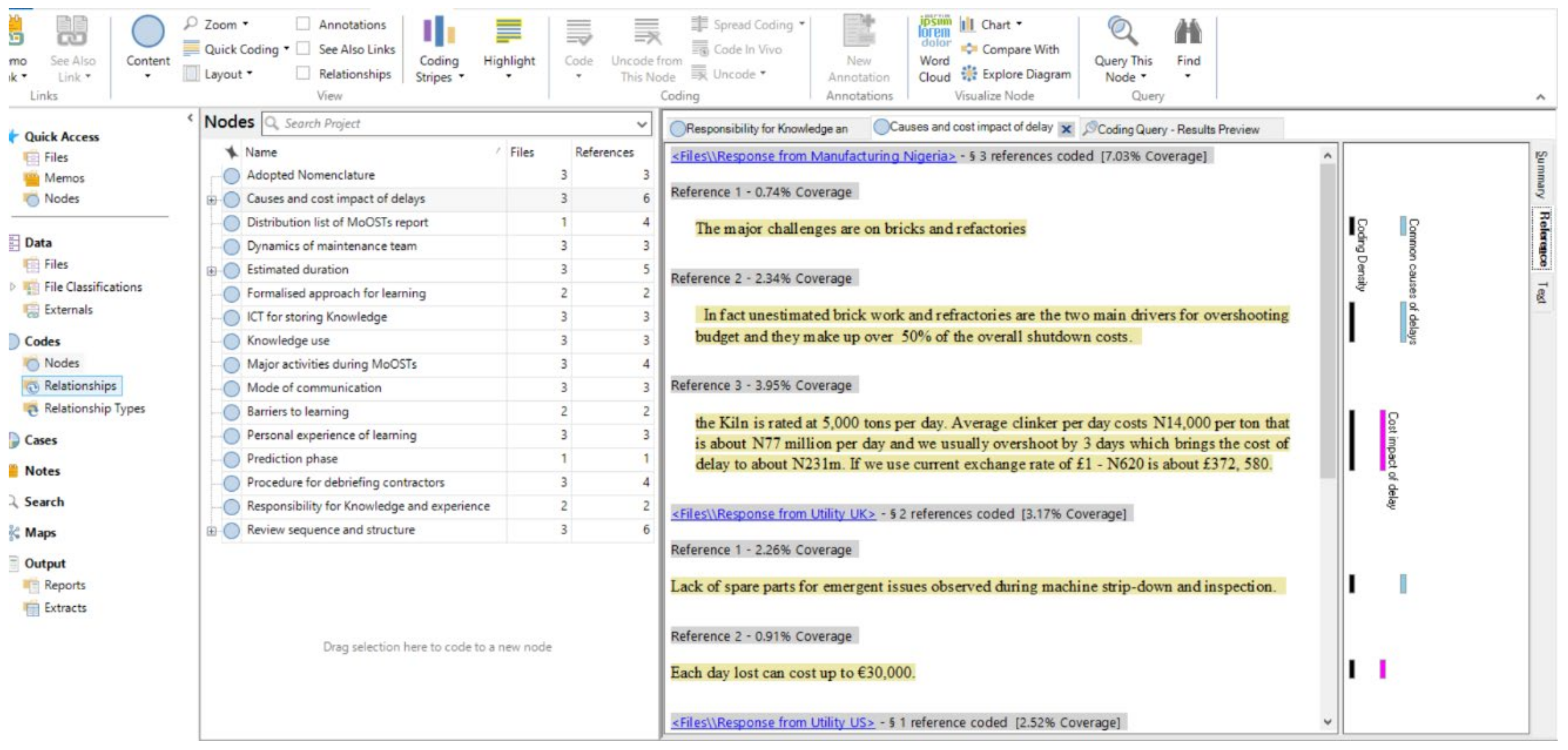
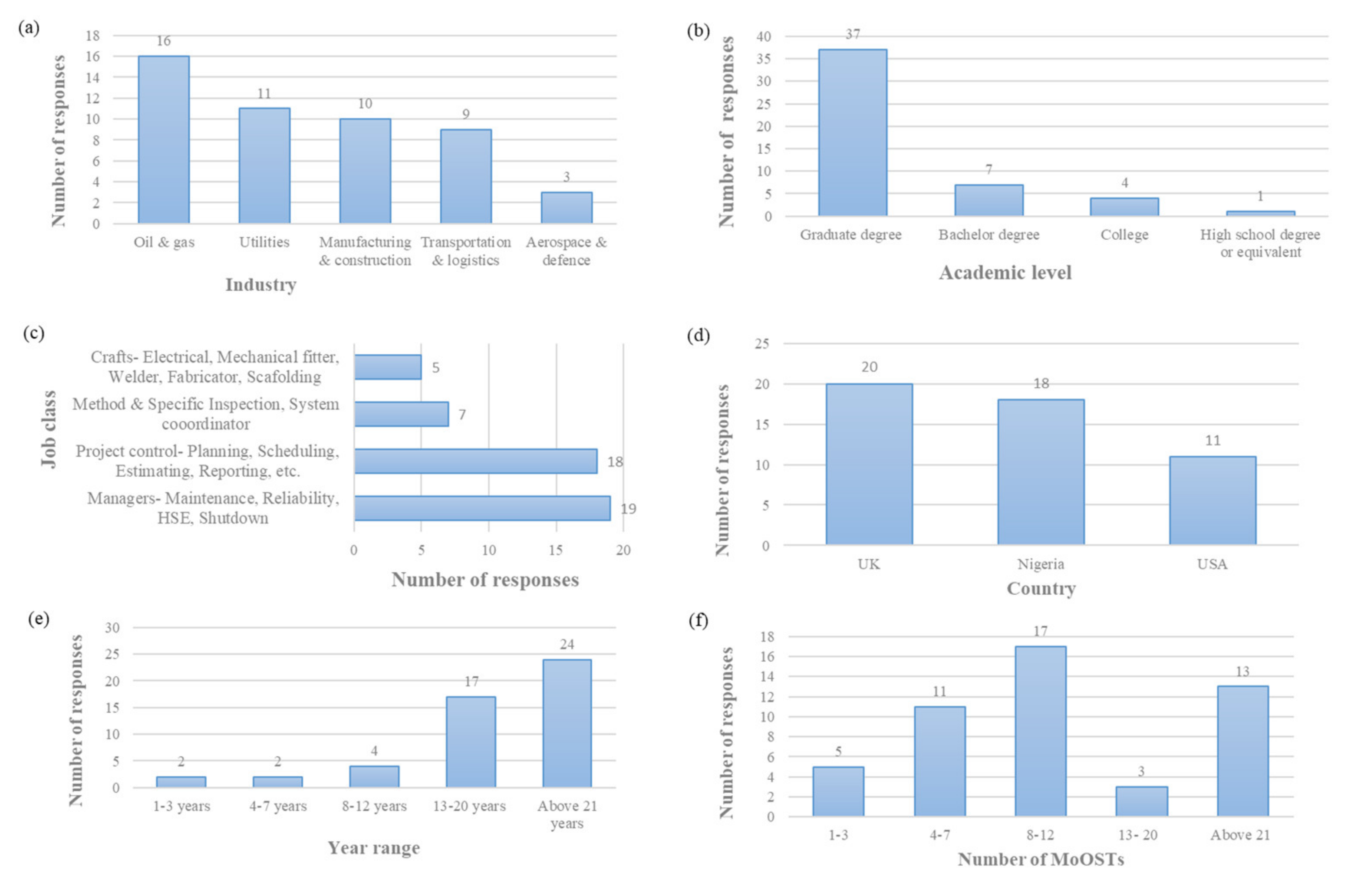
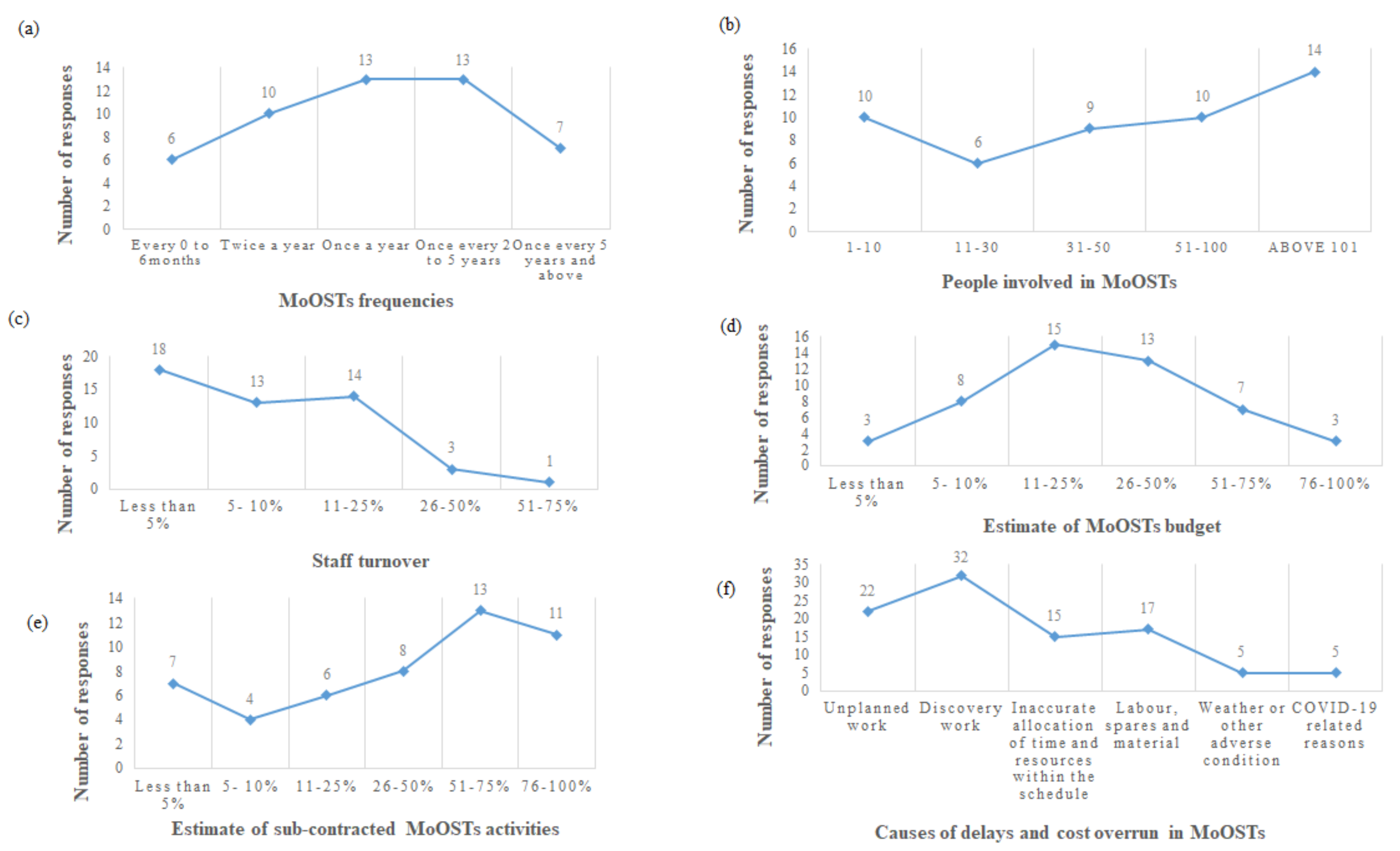
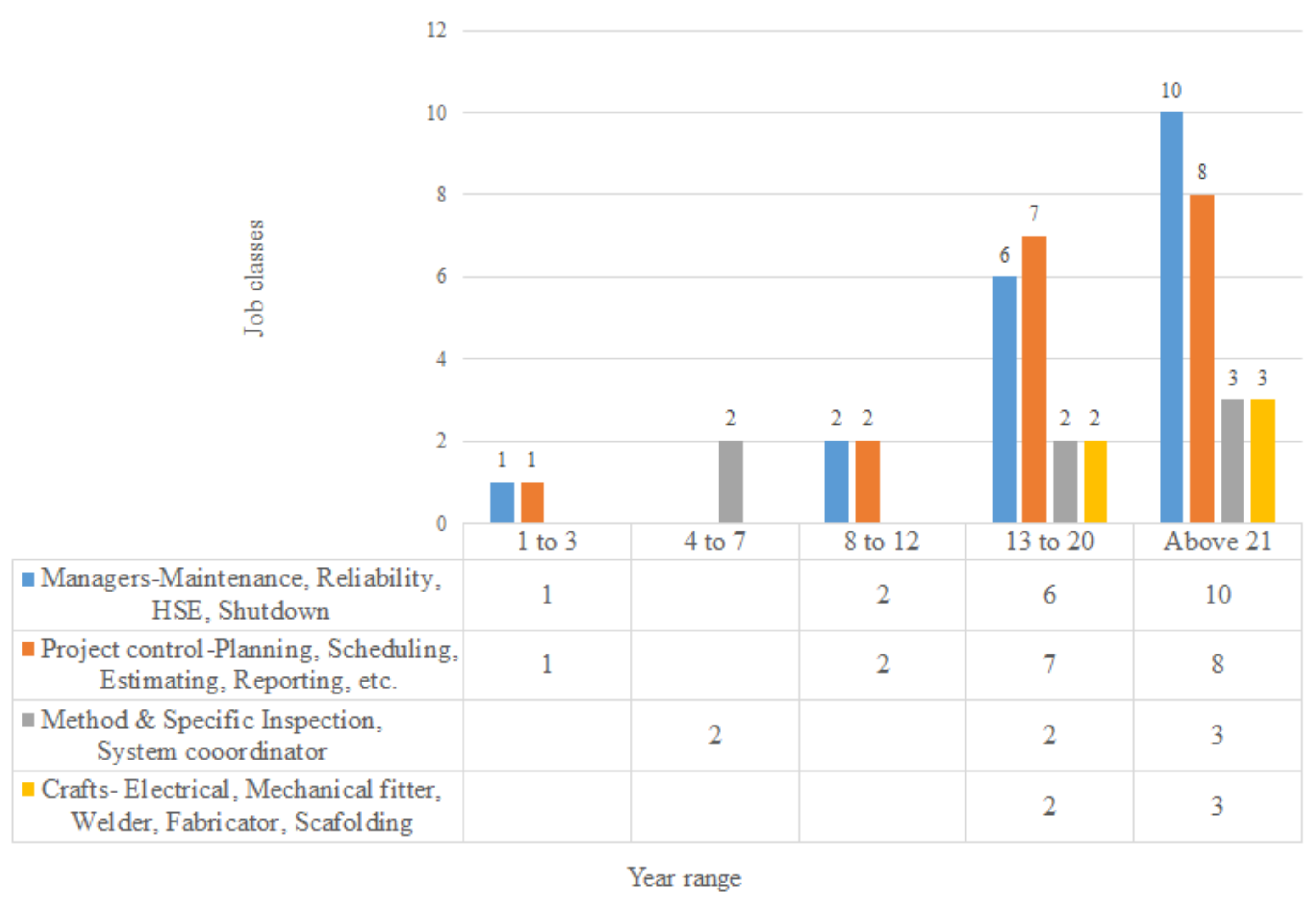

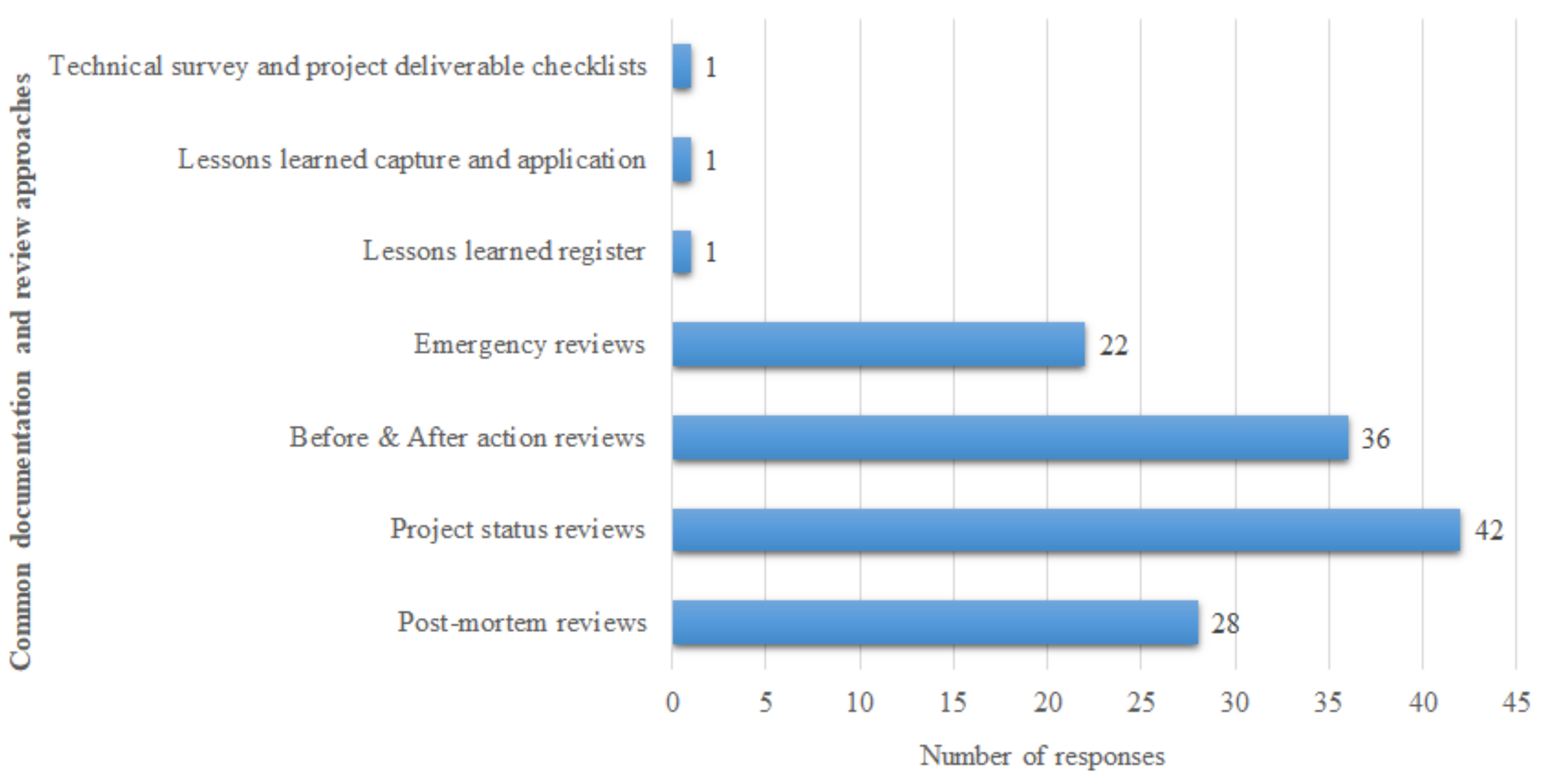
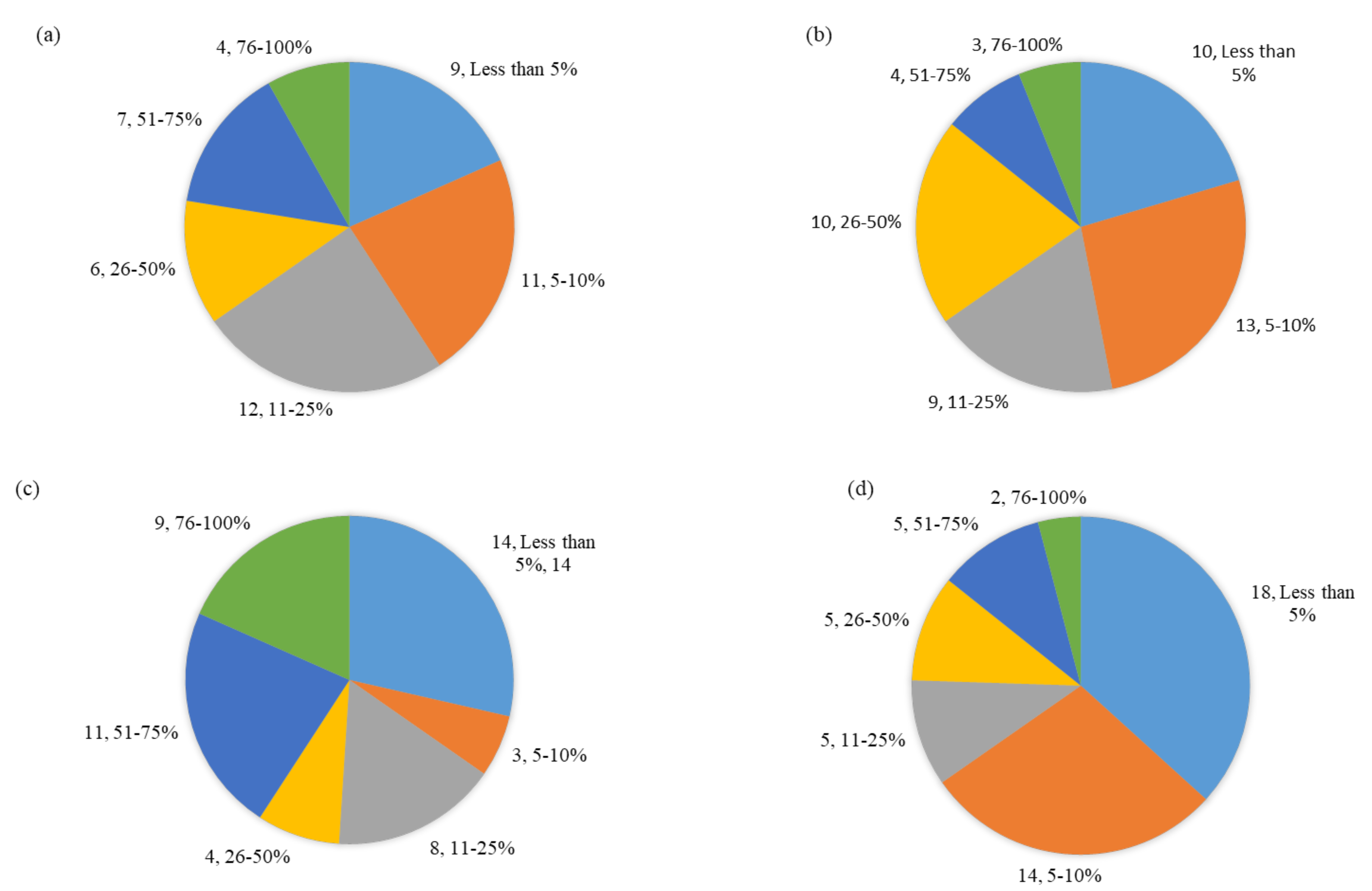
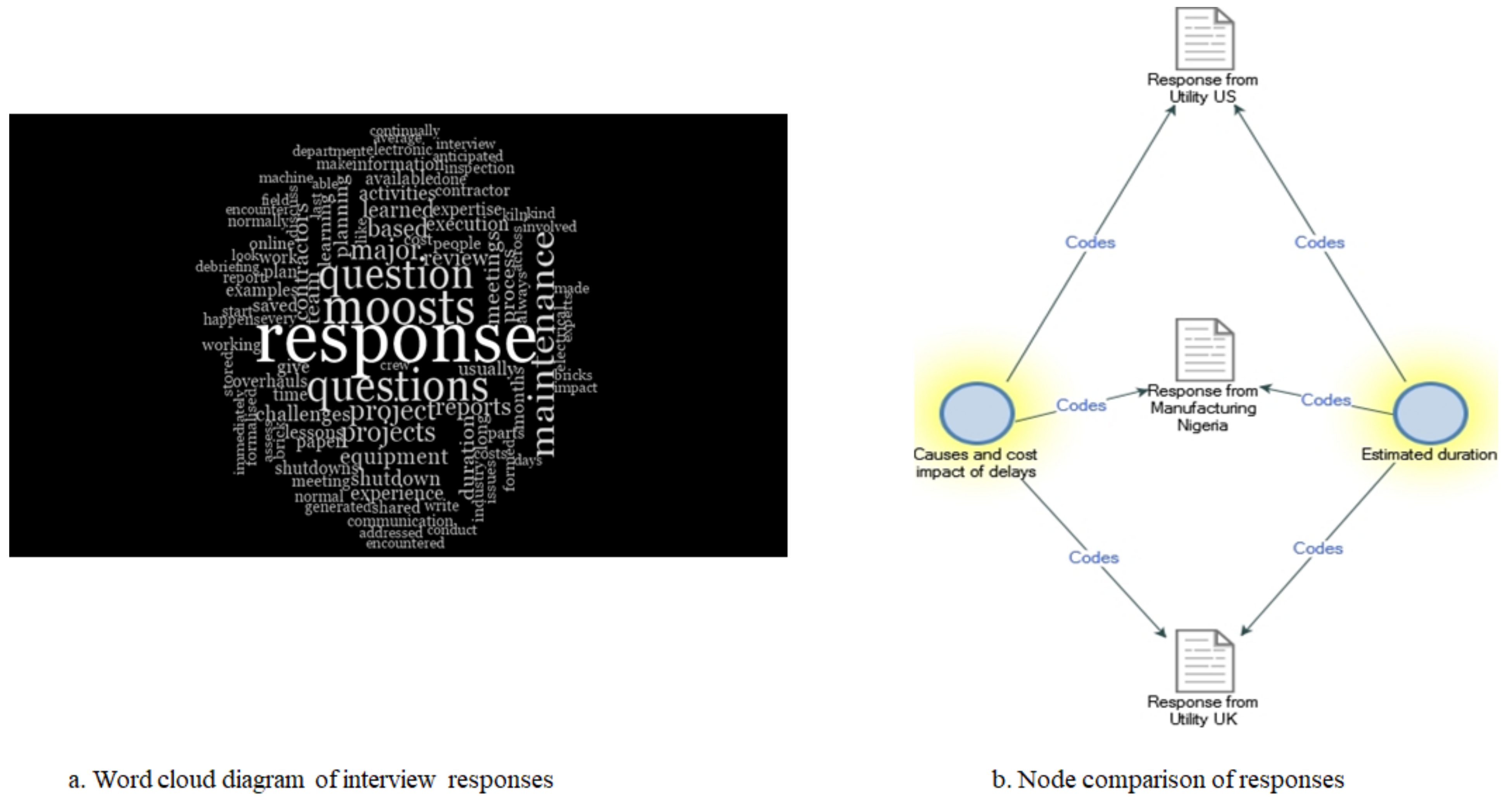
| Industry | Category and Job Class | Number |
|---|---|---|
| Manufacturing-cement |
| 4 |
| 3 | |
| 2 | |
| Utilities-Water |
| 2 |
| 3 | |
| 1 | |
| Total | 15 |
Publisher’s Note: MDPI stays neutral with regard to jurisdictional claims in published maps and institutional affiliations. |
© 2021 by the authors. Licensee MDPI, Basel, Switzerland. This article is an open access article distributed under the terms and conditions of the Creative Commons Attribution (CC BY) license (https://creativecommons.org/licenses/by/4.0/).
Share and Cite
Iheukwumere-Esotu, L..O.; Yunusa-Kaltungo, A. Knowledge Management and Experience Transfer in Major Maintenance Activities: A Practitioner’s Perspective. Sustainability 2022, 14, 52. https://doi.org/10.3390/su14010052
Iheukwumere-Esotu LO, Yunusa-Kaltungo A. Knowledge Management and Experience Transfer in Major Maintenance Activities: A Practitioner’s Perspective. Sustainability. 2022; 14(1):52. https://doi.org/10.3390/su14010052
Chicago/Turabian StyleIheukwumere-Esotu, Lilian .O., and Akilu Yunusa-Kaltungo. 2022. "Knowledge Management and Experience Transfer in Major Maintenance Activities: A Practitioner’s Perspective" Sustainability 14, no. 1: 52. https://doi.org/10.3390/su14010052






